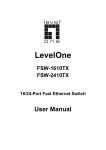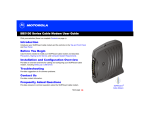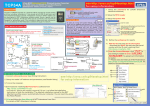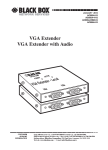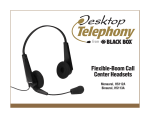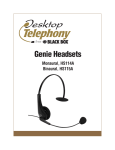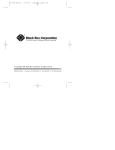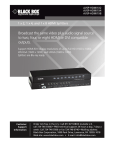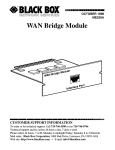Download SDSL Network Extender 2000
Transcript
NOVEMBER 2002 LR0020A-KIT-R2 SDSL Network Extender 2000 der xten rk E two r Unit e N L de SDS Provi Lnk Tx tion c Rx C onne t n isio therne ll o C E Pow er le ilab tion Avaonnec LC SDS er d xten rk E two er Unit e N L rib SDSSubsc Lnk Tx tion c Rx C onne ion ernet is ll Co Eth Pow er le ilab tion Avaonnec LC SDS CUSTOMER SUPPORT INFORMATION Order toll-free in the U.S.: Call 877-877-BBOX (outside U.S. call 724-746-5500) FREE technical support 24 hours a day, 7 days a week: Call 724-746-5500 or fax 724-746-0746 Mailing address: Black Box Corporation, 1000 Park Drive, Lawrence, PA 15055-1018 Web site: www.blackbox.com • E-mail: [email protected] FCC/IC STATEMENTS FEDERAL COMMUNICATIONS COMMISSION AND INDUSTRY CANADA RADIO-FREQUENCY INTERFERENCE STATEMENTS This equipment generates, uses, and can radiate radio-frequency energy and if not installed and used properly, that is, in strict accordance with the manufacturer’s instructions, may cause interference to radio communication. It has been tested and found to comply with the limits for a Class A computing device in accordance with the specifications in Subpart J of Part 15 of FCC rules, which are designed to provide reasonable protection against such interference when the equipment is operated in a commercial environment. Operation of this equipment in a residential area is likely to cause interference, in which case the user at his own expense will be required to take whatever measures may be necessary to correct the interference. Changes or modifications not expressly approved by the party responsible for compliance could void the user’s authority to operate the equipment. This digital apparatus does not exceed the Class A limits for radio noise emission from digital apparatus set out in the Radio Interference Regulation of Industry Canada. Le présent appareil numérique n’émet pas de bruits radioélectriques dépassant les limites applicables aux appareils numériques de classe A prescrites dans le Règlement sur le brouillage radioélectrique publié par Industrie Canada. 1 SDSL NETWORK EXTENDER 2000 EUROPEAN UNION DECLARATION OF CONFORMITY This equipment complies with the requirements of the European EMC directive 89/336/EEC. TRADEMARKS USED IN THIS MANUAL BLACK BOX and the Corporation. logo are registered trademarks of Black Box Any other trademarks mentioned in this manual are acknowledged to be the property of the trademark owners. 2 NOM STATEMENT NORMAS OFICIALES MEXICANAS (NOM) ELECTRICAL SAFETY STATEMENT INSTRUCCIONES DE SEGURIDAD 1. Todas las instrucciones de seguridad y operación deberán ser leídas antes de que el aparato eléctrico sea operado. 2. Las instrucciones de seguridad y operación deberán ser guardadas para referencia futura. 3. Todas las advertencias en el aparato eléctrico y en sus instrucciones de operación deben ser respetadas. 4. Todas las instrucciones de operación y uso deben ser seguidas. 5. El aparato eléctrico no deberá ser usado cerca del agua—por ejemplo, cerca de la tina de baño, lavabo, sótano mojado o cerca de una alberca, etc.. 6. El aparato eléctrico debe ser usado únicamente con carritos o pedestales que sean recomendados por el fabricante. 7. El aparato eléctrico debe ser montado a la pared o al techo sólo como sea recomendado por el fabricante. 8. Servicio—El usuario no debe intentar dar servicio al equipo eléctrico más allá a lo descrito en las instrucciones de operación. Todo otro servicio deberá ser referido a personal de servicio calificado. 9. El aparato eléctrico debe ser situado de tal manera que su posición no interfiera su uso. La colocación del aparato eléctrico sobre una cama, sofá, alfombra o superficie similar puede bloquea la ventilación, no se debe colocar en libreros o gabinetes que impidan el flujo de aire por los orificios de ventilación. 3 SDSL NETWORK EXTENDER 2000 10. El equipo eléctrico deber ser situado fuera del alcance de fuentes de calor como radiadores, registros de calor, estufas u otros aparatos (incluyendo amplificadores) que producen calor. 11. El aparato eléctrico deberá ser connectado a una fuente de poder sólo del tipo descrito en el instructivo de operación, o como se indique en el aparato. 12. Precaución debe ser tomada de tal manera que la tierra fisica y la polarización del equipo no sea eliminada. 13. Los cables de la fuente de poder deben ser guiados de tal manera que no sean pisados ni pellizcados por objetos colocados sobre o contra ellos, poniendo particular atención a los contactos y receptáculos donde salen del aparato. 14. El equipo eléctrico debe ser limpiado únicamente de acuerdo a las recomendaciones del fabricante. 15. En caso de existir, una antena externa deberá ser localizada lejos de las lineas de energia. 16. El cable de corriente deberá ser desconectado del cuando el equipo no sea usado por un largo periodo de tiempo. 17. Cuidado debe ser tomado de tal manera que objectos liquidos no sean derramados sobre la cubierta u orificios de ventilación. 18. Servicio por personal calificado deberá ser provisto cuando: 4 A: El cable de poder o el contacto ha sido dañado; u B: Objectos han caído o líquido ha sido derramado dentro del aparato; o C: El aparato ha sido expuesto a la lluvia; o D: El aparato parece no operar normalmente o muestra un cambio en su desempeño; o E: El aparato ha sido tirado o su cubierta ha sido dañada. TABLE OF CONTENTS Contents Chapter Page 1. Specifications ......................................................................... 6 2. Introduction .......................................................................... 9 3. Installation ........................................................................... 10 3.1 The Complete Package .............................................. 10 3.2 The Installation Procedure ........................................ 10 4. Operation ............................................................................. 16 5. Troubleshooting .................................................................. 18 5.1 Calling Black Box ........................................................ 18 5.2 Shipping and Packaging ............................................. 19 5 SDSL NETWORK EXTENDER 2000 1. Specifications Compliance — EMI/RFI: CE (EN 55022), FCC Part 15 Subpart J Class A, IC Class/classe A, CSA C108.8 Safety: UL® 1950, CSA C22.2 No. 950, EN 60950, IEC 950 Standard — IEEE 802.3 Ethernet v2 Interfaces — 10BASE-T, SDSL SDSL Encoding — G.SHDSL (TC-PAM) Maximum Bandwidth — Is a function of the distance (length) of standard 26-AWG telephone wire between the Provider and Subscriber Units, and is user-configurable to any of these settings: 2.32 Mbps at up to 11,300 ft. (3444 m); 2.064 Mbps at up to 12,200 ft. (3719 m); 1.552 Mbps at up to 12,800 ft. (3901 m); 1.04 Mbps at up to 16,000 ft. (4877 m); 784 kbps at up to 16,800 ft. (5121 m); 528 kbps at up to 18,400 ft. (5608 m); 400 kbps at up to 19,400 ft. (5913 m); 272 kbps at up to 20,200 ft. (6157 m) 6 CHAPTER 1: Specifications User Controls – On Provider Unit: (1) Rear-mounted 3-position DIP switch for data rate Indicators — (6) Front-mounted LEDs on each Provider or Subscriber Unit: SDSL Connection, Power, Ethernet Collision, Ethernet Rx, Ethernet Tx, and Ethernet Link Connectors — Rear-mounted on each Provider or Subscriber Unit: (1) RJ-45 female for Ethernet, (1) RJ-45 female, designed to accept both RJ-45 and RJ-11 plugs, for SDSL Altitude Tolerance — Temperature Tolerance — –200 to +16,400 ft. (–60 to +5000 m) Operating: 32 to 122˚F (0 to 50˚C); Storage: –40 to +158˚F (–40 to +70˚C) Humidity Tolerance — 5 to 95% noncondensing Enclosure — Steel 7 SDSL NETWORK EXTENDER 2000 Power — For each Provider or Subscriber Unit: From utility-power (mains) outlet, through detachable input cord and external wallmount power supply: Input: 100 to 125 VAC (1 amp) at 47 to 63 Hz; Output: 5 VDC at a maximum of 1.5 amps; Consumption: 7.5 watts maximum Size — Each Provider or Subscriber Unit: 1.25"H x 5.5"W x 4.5"D (3.2 x 14 x 11.5 cm) Weight — Each Provider or Subscriber Unit: 0.6 lb. (0.3 kg) 8 CHAPTER 2: Introduction 2. Introduction With the SDSL Network Extender 2000, you can create a long-distance Ethernet connection over your own private telephone wiring using Symmetric Digital Subscriber Line (SDSL) technology, which is far faster than regular dialup, leased-line, or even ISDN links. Here’s how it works: If you can run (or have already run) telephone cabling between the sites you want to connect, put the Extender’s Provider Unit on one end of this cabling and its Subscriber Unit on the other, then attach them to your Ethernet networks at each site. The two Units will send each other all of the data going either direction on the Ethernet bus, at speeds up to 2.32 Mbps (the data rate depends on the length of the cabling between the Units). All you have to do is set the DIP switch once, cable the units, and plug them in. No configuration-—no muss, no fuss. Just a reliable, high-speed connection that’s always on. 9 SDSL NETWORK EXTENDER 2000 3. Installation 3.1 The Complete Package The SDSL Network Extender 2000 comes with a Provider Unit, a Subscriber Unit, a power supply for each Unit, and this manual. (The power supplies are identical; you can use either one with either unit.) If you didn’t receive everything, or if anything arrived damaged, contact Black Box right away. 3.2 The Installation Procedure Take these steps to install your Extender: 1. Referring to Table 3-1 on the next page, set the DIP switch on the Provider Unit for the maximum data rate that the Extender can support, given how long the cable will be between the Provider and Subscriber Units. If you don’t know how long the cabling is, start at the setting for the shortest distance/highest data rate; if the units can’t link up at that speed when you interconnect them later, try settings for progressively higher distances/lower data rates until the link succeeds. 10 CHAPTER 3: Installation Table 3-1. Available DIP-switch settings and the corresponding maximum distances and data rates. Pos. #1 Pos. #2 Pos. #3 Maximum Maximum Bandwidth Distance Down Down Down 2.32 Mbps Down Down Up 11,300 ft. (3444 m); 2.064 Mbps 12,200 ft. (3719 m); Down Up Down 1.552 Mbps 12,800 ft. (3901 m); Down Up Up 1.04 Mbps 16,000 ft. (4877 m); Up Down Down 784 kbps 16,800 ft. (5121 m); Up Down Up 528 kbps 18,400 ft. (5608 m); Up Up Down 400 kbps 19,400 ft. (5913 m); Up Up Up 20,200 ft. (6157 m) 272 kbps NOTE This table assumes 26 AWG cable. You might be able to achieve better data rates or distances if you use cable with thicker wires (22 or 24 AWG). 2. Set DIP switch position #4 Down for half-duplex, and Up for full-duplex. Set this switch for both Provider and Subscriber Units. 11 SDSL NETWORK EXTENDER 2000 NOTE While both ends of the Ethernet connection must have the same duplex mode configuration, partner Provider Units and Subscriber Units don’t have to be configured the same. Duplex mode does not apply to the SDSL connection. In half-duplex mode, Switch #4 is down. Receive and transmit functions are mutally exclusive; data transmission occurs in only one direction at a time. Packet collisions are not uncommon. In full-duplex mode, Switch #4 is up. The Ethernet line can receive and transmit simultaneously, preventing packet collisions and increasing aggregate bandwidth from 10 Mbps to 20 Mbps. 3. Plug the output cord of the Provider Unit’s power supply into the barrel jack on the Unit’s rear panel. 4. Plug the power supply’s input cord into a working AC outlet. Make sure that the Power, Link, Tx, and Rx LEDs light up. 12 CHAPTER 3: Installation 5. Plug your SDSL cable into the RJ-45 jack marked “SDSL” on the Unit’s rear panel. (This jack is designed to accept either RJ-45 or RJ-11 plugs. The SDSL cable should be 22 to 26 AWG telephone cable with Ring and Tip on the center two pins: If it has RJ-45 connectors, Ring should be on Pin 4 and Tip should be on Pin 5. If it uses RJ-11 connectors, Ring should be on Pin 2 and Tip should be on Pin 3.) 6. Perform steps 3 through 5 at the other site with your Subscriber Unit. Please note that the LED operation described in Step 4, above, does not apply to the Subscriber Unit. The only LED that should light is the Power LED. 7. Once the SDSL cable is connected to both the Provider and Subscriber Units, the Connection LED on each Unit should begin pulsing steadily (once per second) to indicate that the SDSL link has been established and is operating. When the Connection LED starts doing this, the Link, Tx, and Rx LEDs should go dark until you plug in the Ethernet cable and an Ethernet connection is established. 13 SDSL NETWORK EXTENDER 2000 NOTES The length and quality of the cabling between the Units directly affects the process by which they establish an SDSL link with each other. Depending on these cable characteristics, it might take anywhere from one to five minutes for the Units to establish the link. If the cabling is too long to support the data rate set on the Provider Unit, the Units will not be able to link up at all. If this happens, simply set the Provider Unit’s DIP switch for the next-lower data rate and the Units will automatically try to link again. Whenever an Extender Unit boots up without an SDSL connection, its Link, Tx, and Rx LEDs will be steadily lit until the SDSL connection is established or the Unit is powered down. (These LEDs won’t light back up, however, if an SDSL connection is lost after having been established.) When a Provider Unit loses the SDSL connection, it will drop its Ethernet link signal (no matter what state the Link LED is in!) so that, if the attached Ethernet device is capable of generating SNMP traps or other remote alerts, your network-administration team can be notified that the link has gone down. 8. Run Ethernet cable from an Ethernet hub, router, switch, etc., to the RJ-45 jack marked “Ethernet” on the Provider Unit’s rear panel. (This cable should be standard 10BASE-T cable with RX+ on Pin 1, RX– on Pin 2, TX+ on Pin 3, and TX– on Pin 6.) When you do this, the Provider Unit’s Link LED should come back ON, verifying the physical Ethernet link, and any or all of the Tx, Rx, and Collision LEDs might begin flashing. 14 CHAPTER 4: Operation NOTE For most applications, a straight-through-pinned cable is used to attach an Extender Unit to a DTE “destination device” such as a PC, while a cross-pinned cable is used to attach an Extender unit to a DCE “communication device” such as a hub or router. If you’re not sure which type of cable to use with a device, consult its manual and/or check the pinout of its port(s); if these aren’t available or you’re still not sure, call Black Box Technical Support. 9. Perform step 8 at the other site with your Subscriber Unit. Once the two Units have established both DSL and Ethernet link at their sites, data will flow normally between the Units, essentially creating a very long Ethernet connection at SDSL speeds. The Extender should now operate continuously without requiring operator intervention. 15 SDSL NETWORK EXTENDER 2000 4. Operation While the SDSL Network Extender 2000 is operating, you can inspect the front-panel LEDs on its Units at any time for status information: LED Meaning Connection Pulses green once per second to show that the SDSL connection is operational and the Unit is receiving either valid data packets or status packets from the other Unit. Power Steadily lit green to show that the Unit is receiving AC power. Collision Flashes red every time there’s a collision on the attached Ethernet segment. Rx Flashes amber every time a data packet is received from the attached Ethernet segment. Steadily lit amber to show that no SDSL connection is present. Tx Flashes amber every time a data packet is sent to the attached Ethernet segment. Steadily lit amber to show that no SDSL connection is present. 16 CHAPTER 4: Operation LED Meaning Link While Rx and Tx flash, steadily lit green to show that an Ethernet link is in place. While Rx and Tx are steadily lit, steadily lit green to show that no SDSL connection is present. 17 SDSL NETWORK EXTENDER 2000 5. Troubleshooting 5.1 Calling Black Box If you determine that your SDSL Network Extender 2000 is malfunctioning, do not attempt to alter or repair it. None of its components contain user-serviceable parts. Contact Black Box Technical Support at 724-746-5500. Before you do, make a record of the history of the problem. We will be able to provide more efficient and accurate assistance if you have a complete description, including: • the nature and duration of the problem; • when the problem occurs; • the components involved in the problem (devices, cables, etc.); • any particular application that, when used, appears to create the problem or make it worse; and • the results of any testing you’ve already done. 18 2/02 © Copyright 2002. Black Box Corporation. All rights reserved. 1000 Park Drive • Lawrence, PA 15055-1018 • 724-746-5500 • Fax 724-746-0746 CHAPTER 5: Troubleshooting 5.2 Shipping and Packaging If you need to transport or ship an Extender Unit: • Package it carefully. We recommend that you use the original container. • Before you ship it back to Black Box for repair or return, contact us to get a Return Authorization (RA) number. 19 2/02 © Copyright 2002. Black Box Corporation. All rights reserved. 1000 Park Drive • Lawrence, PA 15055-1018 • 724-746-5500 • Fax 724-746-0746























